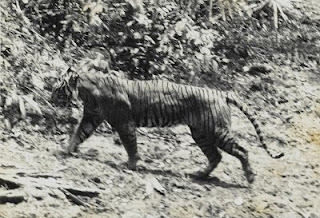Poachers Beware!!
India's Tiger Poaching Crisis
Until recently, habitat loss was thought to be the largest single threat to the future of wild tigers in India. It has now been established that the trade in tiger bones, destined for use in Oriental medicine outside India's borders, is posing an even larger threat. Having decimated their own sources, Far Eastern traditional medicine manufacturers are now targeting India for their supply of tiger bones. Poaching of tigers for the traditional Chinese medicine industry started in northern India in the mid-1980's.
Investigations carried out in 1993-94, during which a total of 36 tiger skins and 667 kilos (1470 pounds) of tiger bones were seized in northern India, brought to light the severity of the problem. The illegal trade is now widespread and in the hands of ruthless, sophisticated operators, some of whom have top level patronage. There is also evidence that profits from the wildlife trade are increasingly being used to fund armed insurgency in north-east and north-west India. A tiger can be killed for as little as just over a dollar for the cost of poison, or $9 for a steel trap. Much of the tiger poaching is done by tribals who know their forests well. They are usually paid a meager amount (in a case near Kanha Tiger Reserve, in May 1994, a trader paid four poachers $15 each for killing a tiger), their hunting talents and knowledge exploited by greedy traders. It is these traders and the middlemen who make substantial profits from the illegal trade in tiger parts.
PENALITIES
If an offence is committed against the Wild Life (Protection) Act, 1972, there is a maximum sentence of three years imprisonment or a fine which may extend to Rs. 25,000 or both.
For an offence against a Schedule I or Schedule II (part 2) animal, or for an offence committed within a sanctuary or natural park, there is a mandatory prison term of three years, which may extend to seven years. There is also a mandatory fine of at least Rs. 10,000. For a subsequent offence, the mandatory prison remains same, while the mandatory fine is at least Rs.25, 000.
For an offence committed inside the core area of a Tiger Reserve, there is a mandatory prison term of three years, extendable to seven years and a fine of Rs. 50,000 extendable to Rs. 2 lakhs. In case of a subsequent conviction, there is an imprisonment of at least seven years and a fine of Rs. 5 lakhs which may extend to Rs. 50 lakhs.
Despite these penalties, the laws are difficult to enforce and to date, in spite of hundreds of cases, only 16 people have ever been convicted of killing a tiger.
For an offence against a Schedule I or Schedule II (part 2) animal, or for an offence committed within a sanctuary or natural park, there is a mandatory prison term of three years, which may extend to seven years. There is also a mandatory fine of at least Rs. 10,000. For a subsequent offence, the mandatory prison remains same, while the mandatory fine is at least Rs.25, 000.
For an offence committed inside the core area of a Tiger Reserve, there is a mandatory prison term of three years, extendable to seven years and a fine of Rs. 50,000 extendable to Rs. 2 lakhs. In case of a subsequent conviction, there is an imprisonment of at least seven years and a fine of Rs. 5 lakhs which may extend to Rs. 50 lakhs.
Despite these penalties, the laws are difficult to enforce and to date, in spite of hundreds of cases, only 16 people have ever been convicted of killing a tiger.
POACHING METHODS
Poachers use one of the following methods to kill a wild tiger:
Poison - which is usually placed in the carcasses of domestic buffaloes and cows. During the dry, hot summer months small forest pools are also poisoned by poachers, or depressions dug and filled with water for this purpose. There is a sophisticated and well organised supply route operated by the major traders, to distribute poison and collect tiger bones from the remotest villages. .Steel Traps - which are made by nomadic blacksmiths. These traps are immensely strong. In a tiger poaching case near Raipur in 1994, it took six adult men to open a trap. In one area in central India, investigators found that so many steel traps had been set that the villagers were fearful of going into the forest. People have received dreadful injuries from these traps.Firearms - are used where hunting can be carried out with little hindrance.Electrocution - by tapping 230 volts -11KV overhead electrical wires and laying a live wire on animal tracts.
Tiger poaching occurs in all areas where large number of tigers have been recorded. Poaching is particularly prevalent in the States of Madhya Pradesh, Uttar Pradesh, West Bengal, Bihar, Maharashtra, Andhra Pradesh, Karnataka, Kerala, Rajasthan, Uttarakhand and Assam.


Comments
Post a Comment